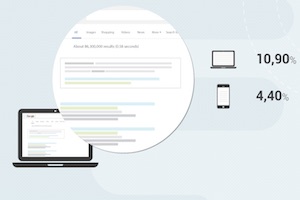
Google's search engine is displaying fewer organic results on it first page this year than it was last year, and it's increasingly presenting different experiences for desktop and smartphone users, according to recent research from Searchmetrics.
The report was based on 2016 data from 500,000 general, frequently searched keywords. The researchers examined the first Google search results page for each term and analyzed how 11 features (text results, product listing ads, images, news, maps, etc.) were integrated.
Whereas Google used to almost always display 10 standard, text-based organic results on its first page, the search engine now usually presents fewer results: 8.59 results are presented to desktop users, on average, and 8.5 are presented to smartphone users, on average.
A key reason for the decline in the number of traditional search results presented on the first page is that Google is integrating an increasing number of supplementary boxes/features. Some 34% of the desktop results for the keywords examined by the researchers included image results, 24% video results, and 20% Knowledge Graph results.
Consumers searching on desktop computers are more likely than smartphone searchers to receive Google results with images, product listing ads, and fact/answer boxes; smartphone searchers are more likely than desktop searchers to receive results with video, map, social, and mobile app integrations.
Check out the infographic for more insights from the report.

About the research: The report was based on 2016 data from 500,000 general, frequently Googled search terms. The researchers examined the first search results page for each term and analyzed how 11 features (text results, product listing ads, images, news, maps, etc.) were integrated.
Source: How Google Search Has Changed in 2016 [Infographic]
No comments:
Post a Comment